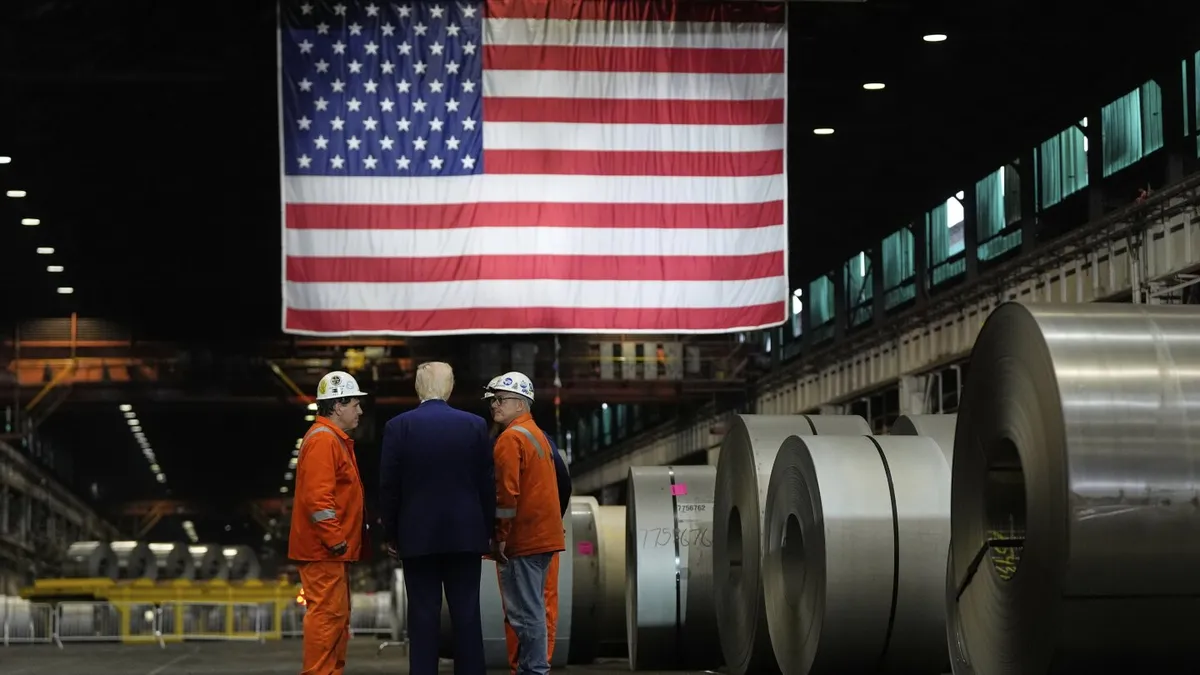
As President Donald Trump gears up to announce significant new tariff increases, the implications of his trade policies are becoming increasingly evident for the domestic manufacturing sector. A recent analysis indicates that factory costs could surge by approximately 2% to 4.5%. Chris Bangert-Drowns, a researcher at the Washington Center for Equitable Growth, who conducted this analysis, warns, “There’s going to be a cash squeeze for a lot of these firms.” These seemingly minor cost adjustments at factories, especially those operating on slim profit margins, could lead to stagnated wages, potential layoffs, and even plant closures if the new costs prove to be unsustainable.
The analysis, released on a Tuesday, highlights the difficulties Trump may face in convincing the public that his tariffs represent a political and economic victory rather than mere evidence of his negotiating style. The ultimate success of Trump's policies hinges on whether they genuinely improve the wealth of everyday Americans and revitalize factory towns—a goal that economists believe may not be achievable through tariffs alone.
Trump has initiated new tariff frameworks with various countries, including the European Union, Japan, Philippines, Indonesia, and Britain, which will increase the import taxes imposed by the United States. Starting this Friday, he is set to levy tariffs on goods from numerous other countries, ranging from 15% to 50%. Although the U.S. stock market has reacted positively to the lower-than-expected tariff rates, concerns persist regarding the longer-term economic impact, particularly as these tariffs may lead to higher prices and hinder growth.
A June survey conducted by the Atlanta Federal Reserve suggested that companies would, on average, pass about half of their tariff costs onto U.S. consumers through increased prices. This comes at a time when Labor Department data indicates a loss of 14,000 manufacturing jobs following the implementation of April’s tariffs. The pressure is mounting to see if a rebound in manufacturing employment will emerge in the upcoming June employment report.
The Washington Center for Equitable Growth's analysis underscores the economic and political ramifications associated with Trump's tariff policies. In crucial swing states like Michigan and Wisconsin, over 20% of jobs are concentrated in manufacturing, construction, mining, and oil drilling sectors, all of which are significantly impacted by import taxes. Additionally, the artificial intelligence sector, which Trump recently touted, is heavily reliant on imports, with over 20% of the inputs for computer and electronics manufacturing sourced from abroad. Increased tariffs could exacerbate the already substantial costs associated with developing technology in the U.S.
The White House argues that American businesses will gain access to new markets because of these trade frameworks, asserting that companies will ultimately benefit. “The ‘Made in USA’ label is set to resume its global dominance under President Trump,” stated White House spokesman Kush Desai. However, there remains considerable uncertainty regarding the overall economic impact, as the actual rates of tariffs have fluctuated, and the analysis does not account for how these costs will be shared among foreign producers, domestic manufacturers, and consumers.
Moreover, the legal justification for the tariffs, framed as an “emergency” act, is currently under review by a U.S. appeals court. Treasury Secretary Scott Bessent commented that countries are essentially accepting the tariffs to maintain access to the U.S. market, implying a toll is being paid. However, this overlooks the burden placed on U.S. manufacturers, who are feeling the pinch from multiple directions. Justin Johnson, president of Jordan Manufacturing Co. in Belding, Michigan, expressed concerns over rising costs, noting that the price of a key raw material, steel coil, has increased by 5% to 10% this year due to tariffs imposed on imported steel and aluminum.
Despite the Trump administration's insistence that tariffs are not driving inflation, many businesses are experiencing rising costs. A report from the Council of Economic Advisers claims that the price of imported goods fell between December last year and May, contradicting concerns about accelerating inflation. Nonetheless, Ernie Tedeschi, director of economics at the Budget Lab at Yale University, argues that a more accurate comparison of import prices shows an upward trend in recent months. The Budget Lab estimates that tariffs will cost the average household about $2,400 in lost purchasing power.
Josh Smith, founder and president of Montana Knife Co., is a Trump supporter who acknowledges that tariffs on foreign steel and goods pose a threat to his business. Recently, he ordered a $515,000 machine from Germany, which will incur a 10% tax escalating to 15%. This tariff adds $77,250 to his costs, a sum that could have otherwise been allocated to hiring an entry-level worker. Smith is eager to purchase more American-made equipment, but the reality is that there are limited options available domestically.
As tariffs continue to reshape the landscape of American manufacturing, many business owners like Smith are caught in a challenging position, navigating rising costs and uncertain market conditions. “The average American is not in my situation, looking at the numbers and making daily decisions. I want to invest in my business and hire more employees, but the prospect of tariffs complicates that,” he noted. The ongoing economic environment remains precarious, as manufacturers strive to adapt to the evolving challenges presented by Trump's trade policies.